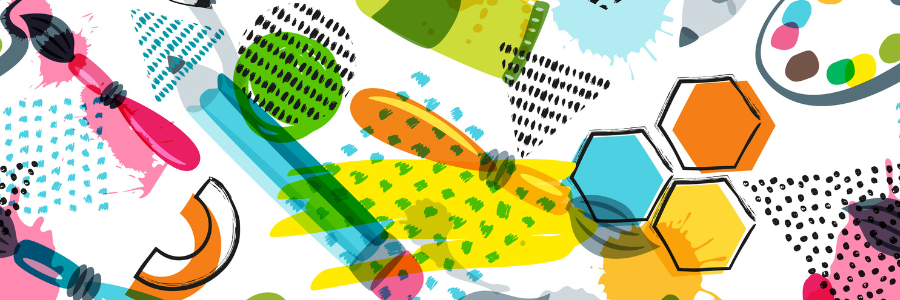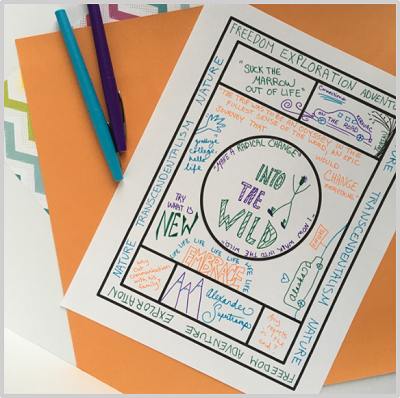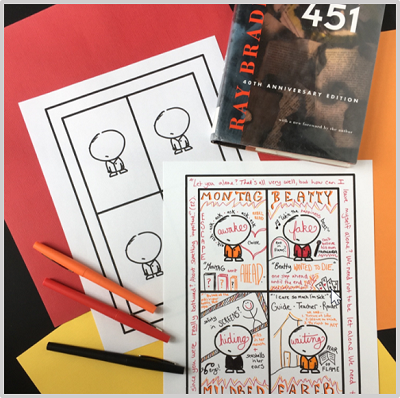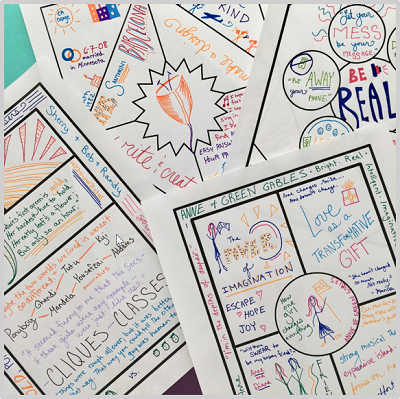

BLOGS > AUGUST 4, 2021
BY BETSY POTASH

But are one-pagers really all about art? At its core, a one-pager (originally developed as a classroom tool by AVID) is a no-fluff, just-the-good-stuff version of a set of information. In the business world, a boss might ask an employee to create a one-pager of six months of research so the boss can catch up. In English class, a teacher might ask a student to create a one-pager out of an entire novel, pulling the most important information and ideas from its pages and sharing it through words and images. Either way, it’s about finding the core of what’s worth taking away from something.
One-pagers can seem like the best or the worst pedagogic tool available, depending on what example you happen to be looking at. We tend to see the upper reaches of the example mountain on Instagram. But can one-pagers be useful even if your students aren’t planning their tours of Rhode Island School of Design (RISD)?
It turns out they can.
To find success with one-pagers, just follow three simple steps.
While you’re sure to get some interesting one-pagers if you ask students to simply condense what’s important about a text or unit into one page of information and images, you’re also going to get some terrible ones. It helps students succeed with one-pagers if you lay out exactly what you want included.
For example, for a one-pager on a novel, you might bullet the following elements:
You can tailor these expectations to any type of information, whether you’re asking for a one-pager on a novel, poem, short story, film, or podcast. You can even use one-pagers as a tool to learn more about students, having them create one-pagers about themselves, their reading histories or their families.

Creating a short rubric that shows how hitting the important elements thoughtfully leads to a strong grade on the assignment. This will help take away the anxiety from students who are uncomfortable with art. It will also make it a lot easier for you to quickly grade your one-pagers and get them up into a display on your classroom wall.

Even with a list of elements to include and a rubric, many students (especially those who hate art), will feel nervous around one-pagers at first. That’s where templates come in. Simply create a page divided into shaped sections and attach each necessary element to a section. It’s amazing how much it helps students relax into the assignment if instead of asking them to include two themes, you ask them to include two themes in the upper left hand rectangle. Simple, but highly effective.
Of course, some students will prefer artistic freedom. Simply differentiate by offering the template as an option, and let students choose. You’ll get creative work through both formats.
Once you get going with one-pagers, you’ll quickly see how versatile they are and how much the combination of imagery and ideas makes information memorable to your students.

Be sure to save time (once the one-pagers are created) for a gallery walk or mini-presentations to a partner or small group. Let your students see each other’s one-pagers so they continue to expand their ideas of what one-pagers can be like so they’re ready for further depth and innovation the next time you assign one.
|

BETSY POTASH
Betsy’s passion is helping English teachers build innovative and creative lessons. Get inspired and follow along with her at
Discover best-selling Spanish SEL-oriented picture books!
April 23, 2024
Explore the exciting selection of stand-alone titles and series from Vista Higher Learning where students meet diverse characters and connect with engaging stories! These titles feature vibrant illustrations that bring stories to life and are essential for Spanish-language comprehension. From...
Read more
Classroom Libraries Part 1: Organizing & Designing Your Classroom Library
April 12, 2024
We all know that books are essential for learning, and as educators we buy them, collect them, receive them, but then what? We have some great and not-so-great books in our classrooms, and it’s hard to decide what goes into...
Read more
The Top 5 Strategies for Cost-Effective IT Management in K-12 Schools and Districts
April 9, 2024
Introduction IT management has become much more than just keeping the lights on in the computer lab. It's about creating an environment where technology enhances learning without breaking the bank. Let's dive into the top five strategies that will not only save you pennies but...
Read more
Enjoy free digital access to books releasing this summer!
April 8, 2024
Follett partnered with Penguin Young Readers Group and NetGalley* to provide digital access to upcoming fiction titles through August 27. Get early access to favorite topics – novels in verse, mystery, realistic fiction, friendship – then preorder the books you...
Read more
Future-Proofing Education: Why Cloud Hosting Is Key to Technological Advancement
April 8, 2024
In an era where technology evolves at lightning speed, the education sector cannot afford to lag. For K-12 school districts, maintaining a robust, scalable, and secure IT infrastructure is not just about keeping pace with current trends but ensuring they...
Read more
Spring into the new season with the most sought out titles!
March 25, 2024
Well-known librarian Shannon McClintock Miller has selected 13 elementary titles from Capstone Publishing as must-reads for your readers. Including fiction and nonfiction and a variety of genres, these books focus on interesting topics and subject matter that students want to...
Read more